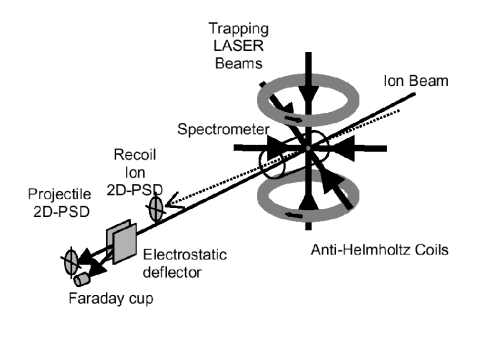FIRST RESULTS WITH THE KSU MOTRIMS:CHARGE TRANSFER IN
Cs+ + Rb(5s), Rb(5p) and Na+ + Rb(5s), Rb(5p) LOW ENERGY COLLISIONS
X. Flechard, H. Nguyen, H.A. Camp, C.W. Fehrenbach, C.L. Cocke, and B.D. DePaola
J.R. Macdonald Laboratory, Department of Physics, Kansas State University,
Manhattan, Kansas, 66506-2604 USA
For more than a decade, Cold Target Recoil Ion Momentum Spectroscopy (COLTRIMS) has been
continually developed and improved, becoming a powerful tool for the study of collision processes1.
This recent technique allows the simultaneous determination of the final charge state and of the
final momentum vector of a recoiling target ion produced in a collision between an atom and any
ionizing particle. The information imparted in this vector gives then access to the kinematics of
the reaction. The success of COLTRIMS mostly lies in a large detection solid angle (nearly 4 pi),
combined with high resolution in the measurement of the three components of the recoil ion momentum.
Nevertheless, this resolution is ultimately limited by the target temperature, and with a traditional
target delivered by a supersonic jet, the typical temperature is not better than 100 mK. To further
push this temperature limit, several groups have recently developed an apparatus that uses atoms
confined in a Magneto-Optical Trap2 (MOT) instead of a supersonic jet. The resulting cold, localized
target is ideal for making measurements using recoil-ion momentum spectroscopy, and the very low
temperature of the trapped atoms should significantly improve the resolution3. In addition, many
alkalis that cannot easily be used in a supersonic jet are particularly easy to trap with a MOT.
MOTRIMS thus also increases the variety of the target species previously accessible to COLTRIMS.
This new technique has recently been used to perform kinematically complete experiments for charge
transfer processes study in Cs+ + Rb(5s), Rb(5p) and Na+ + Rb(5s), Rb(5p) low energy collisions.
Results from this study will be presented.
Figures:

Figure 1:
Experimental setup schematic: Six laser beams and a magnetic field produced by anti-Helmotz
coils achieve the Rb trapping. Recoil ions resulting from charge transfer are extracted by the
spectrometer electric field and detected by a two dimensional position sensitive detector.
Downstream, an electrostatic deflector steers the primary beam toward a Faraday cup whereas the
neutral projectiles are detected by another two dimensional position sensitive detector.
In order to optimize the resolution on the Q value measurement, the recoil ion extraction
axis has been chosen quasi parallel to the beam axis.
References:
1) J. Ulrich et al., J.Phys.B 30, 2917 (1997)
2) E.L. Raab et al., Phys. Rev. Lett. 23, 2631-2634 (1987)
3) S. Wolf and H. Helm, Phys. Rev. A 62, 1-8 (2000)
This work was supported by the
Chemical Sciences, Geosciences and Biosciences Division,
Office of Basic Energy Sciences,
Office of Science,
U.S. Department of Energy.
Submitted to ICPEAC 2001, July 2001 in Santa Fe, NM.
This abstract is also available in
Postscript or
Adobe Acrobat formats.
